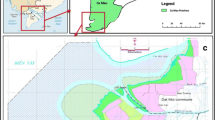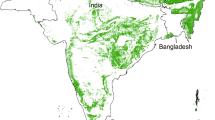Abstract
The present study attempts to assess the biological richness in Sunderban Biosphere Reserve (SBR) using a three-pronged approach i.e. satellite image (IRS 1D LISS-III) for vegetation/land use stratification, landscape analysis for disturbance regimes assessment and the disturbance regimes together with the ecosystem uniqueness, species richness and importance value for biological richness modelling. The study showed that four mangrove categories, viz., Avicennia, Phoenix, mixed mangroves and mangrove scrub, cover 23.21 per cent of the total geographical area of SBR. The largest area is occupied by mixed mangroves (18.31%). The overall accuracy of the vegetation/land use map worked out to be 91.67 per cent. The disturbance analysis revealed that the vegetation types were not much disturbed. Shannon-Weaver’s index of diversity was highest in case of mixed mangrove. The results revealed that 75 per cent forest area has high biological richness.
Similar content being viewed by others
References
Anonymous (2008) State of Forest Report 2005. Forest Survey of India, Dehradun, India
Aschbacher J, Ofren RS, Delsol JP, Suselo TB, Vibulsresth S and Charrupat T (1995) An integrated comparative approach to mangrove vegetation mapping using remote sensing and GIS technologies: preliminary results. Hydrobiologia 295: 285–294
Banerjee AK (1964) Forests of Sundarban. Forest Department, Calcutta, West Bengal, Centenary Volume, pp. 166–185
Banerjee LK (2002) Sundarbans Biosphere Reserve. In: Floristic diversity and conservation strategies in India (Eds.: NP Singh and KP Singh), vol. V, Botanical Survey of India. Ministry of Environment and Forests, pp. 2801–2829
Behera MD, Kushwaha SPS and Roy PS (2000) High plant endemism in Indian hotspot-eastern Himalaya. Biodiversity and Conservation 11(4): 669–682
Belal A and Springuel I (1996) Economic value of plant diversity in arid environments. Nature and Resources 31(1): 33–39
Blasco F (1977) Outlines of Ecology, Botany and Forestry of the Mangals of the Indian Subcontinent. In: Ecosystem of the world: Wet Coastal Ecosystem (Ed.: VJ Chapman), New York, pp. 241–260
Champion HG and Seth SK (1968) A Revised Survey of the Forest Types of India. Manager of Publications, New Delhi
Chaudhuri AB and Choudhury A (1994) Mangroves of Sunderbans, vol. 1, India
FAO (2007) The World’s Mangroves 1980–2005. FAO Forestry Paper 153, Rome, pp. 77
Forman R and Godron M (1986) Landscape Ecology. John Wiley & Sons, New York
Green EP, Clark CD, Mumby PJ, Edwards AJ and Ellis AC (1998) Remote sensing techniques for mangrove mapping. International Journal of Remote Sensing 19: 935–956
Kushwaha SPS, Behera MD and Roy PS (2002) Assessment of biological richness in Subansiri district using remote sensing and GIS. Proc. Workshop on Biodiversity and Environment: Remote Sensing and Geographic Information System Perspectives, 8–9 February, 2000, Dehradun, pp. 153–158
Kushwaha SPS, Padmanaban P, Kumar D and Roy PS (2005) Geospatial modeling of biological richness in Barsey Rhododendron sanctuary in Sikkim Himalaya. Geocarto International 20(2): 63–68
Lillesand TM and Kiefer RW (2000) Remote Sensing and Image Interpretation. Fourth Edition, John Wiley and Sons, New York
Lyon JG (1983) Landsat-derived land cover classification for locating potential Kestrel nesting habitat. Photogrammetric Engineering and Remote Sensing 49(2): 245–250
Mas J (1999) Monitoring land-cover changes: a comparison of change detection techniques. International Journal of Remote Sensing 20: 139–152
Nandy S (2009) Geospatial modelling of biological richness for conservation prioritization of Sunderban mangroves. Ph.D Thesis, Forest Research Institute University, Dehradun
Naskar KR and Chakraborty NM (1984) Studies on the Economic fauna from the Sundarbans delta in West Bengal. Journal of the Indian Society of Coastal Agricultural Research 2(1): 56–62
Odum EP (1971) Fundamentals of Ecology, 3rd edn., W.B. Saunders Co., Philadelphia
Ramsey EJ and Jensen JR (1996) Remote sensing of mangrove wetlands: relating canopy spectra to site-specific data. Photogrammetric Engineering and Remote Sensing 62: 939–948
Romme WH (1982) Fire and landscape diversity in sub-alpine forests of Yellowstone National Park. Ecological Monographs 52: 199–221
Roy PS and Tomar S (2000) Biodiversity characterization at landscape level using geospatial modeling technique. Biological Conservation 95: 95–109
Roy PS, Padalia H, Chauhan N, Porwal MC, Gupta S, Biswas S and Jagdale R (2005) Validation of geospatial model for biodiversity characterization at landscape level-a study in Andaman and Nicobar islands, India. Ecological Modelling 185: 349–369
Shannon CE and Weaver W (1949) The Mathematical Theory of Communication. Urbana, IIinois, pp. 117
Verheyden A, Dahdouh-Guebas F, Thomaes K, De Genst W, Hettiarachchi S and Koedam N (2002) High-resolution vegetation data for mangrove research as obtained from aerial photography. Environment, Development and Sustainability 4: 113–133
Author information
Authors and Affiliations
Corresponding author
About this article
Cite this article
Nandy, S., Kushwaha, S.P.S. Geospatial modelling of biological richness in Sunderbans. J Indian Soc Remote Sens 38, 431–440 (2010). https://doi.org/10.1007/s12524-010-0045-3
Received:
Accepted:
Published:
Issue Date:
DOI: https://doi.org/10.1007/s12524-010-0045-3




